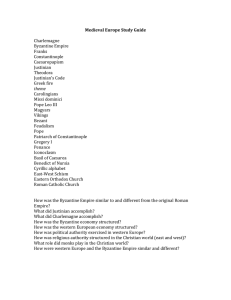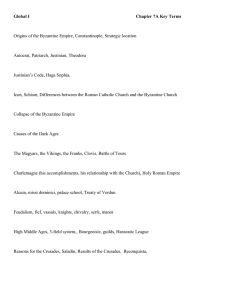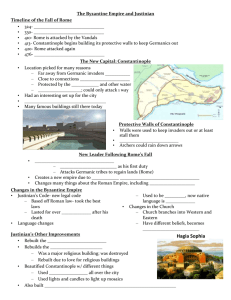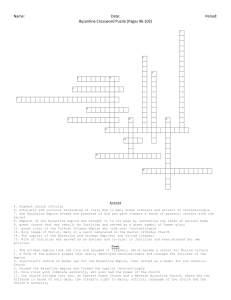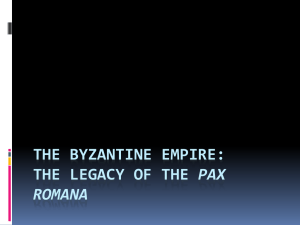The Byzantine Empire
advertisement
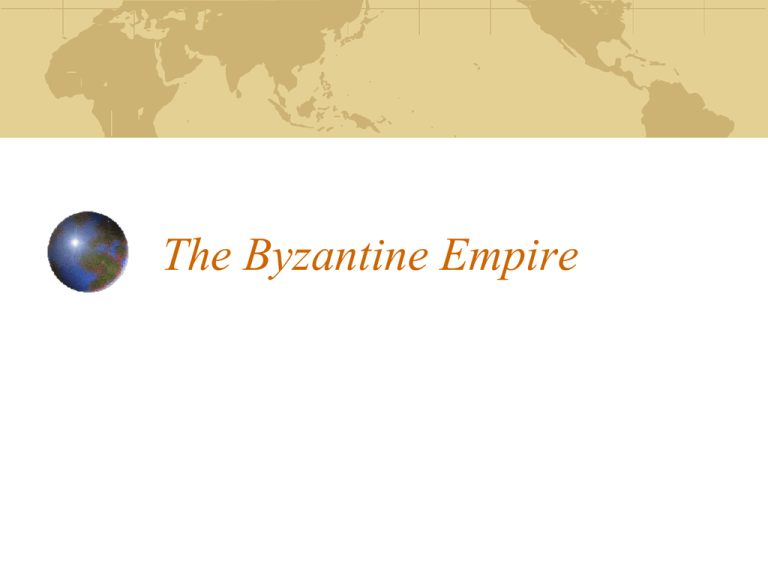
The Byzantine Empire Byzantium ca. 1000 Overview Controlled important territory in the Balkans, the northern middle east, and the eastern Mediterranean Political heir to Rome but with own geography and focus Empire lasted 1,000 years between Rome’s collapse and the final overthrow of the regime by Turkish invaders Constantinople was a great city of the world Orthodox Christian churches spread Expanded a major civilization to part of the world not controlled by one- western Russia (current Ukraine and Belarus) Huge impact on Russia Crucial to understand the similarities and differences of the two Christian churches Origins of the Empire In some senses began in 4th century when Romans (Constantine) set up eastern capital in Constantinople (built on modest town called Byzantium) and separate rulers ruled this portion of the empire Latin was language for centuries until Justinian changed it to Greek, which enabled scholars to read ancient Greek texts Benefited from high levels of commerce (new “blood” in bureaucratic positions) Successfully warded off invasions by Sasanian Empire in Persia and the Huns Justinian’s Achievements 533 CE tried to conquer the west again (heavily influenced by his wife Theodora) Contributions lay in rebuilding Constantinople Hagia Sophia; codification of Roman law; and short-term military conquest (Belisarius made gains in North Africa and Italy but soon were lost) Westward ambitions ultimately weaken empire. Wars cost money- so , increased taxes Arab Pressure and the Empire’s Defenses Justinian’s successors concentrated on defending the eastern empire Mid 7th-century Arab’s challenging Byzantine naval supremacy and repeatedly attack Constantinople 717-718 CE attack on the capital beaten back because of a new weapon, Greek fire (petroleum, quicklime, and sulfur mixture), that devastated Arab ships Again, money needed for defense, so more taxes. This ultimately weakened the rural population and forced them to greater dependence Muslims conquer Crete in 9th century, which allows them to harass Byzantine shipping in the Mediterranean Bulgaria also pressed down on Balkans but ultimately gets defeated and joins part of the empire in Constantinople Society and Government Similarities to early patterns in China- emperor ordained by god- Mandate of Heaven; At key points women held imperial throneEmpress Theodora (981-1056) Very elaborate bureaucracy Bureaucrats could be recruited from all classes of society, so aristocrats dominated but talent came from elsewhere as well (china sim.) Specialization of bureaucrats Elaborate system of spies Careful military organization Economy Economically dependent on Constantinople’s hold over countryside. Peasant class provided goods and bulk of tax revenues and food prices were kept artificially low to keep them content Had luxury goods Merchant class had little political power Icons and Iconoclasm Culturally depended on secular traditions of Hellenism Icon painting- paintings of saints and other religious figures, often richly ornamented Iconoclasm- breaking of images Split Between East and West General orientation towards Asia and Eastern Europe Translation of the Greek Bible into Latin Attempt for the Pope to gain control (incl. intervening in icon dispute) Religious art different All these reasons above helped divide it but not permanently separate it 1054- church patriarch in Constantinople raised old issues leading the Pope to excommunicate him and his followers. In turn, the patriarch excommunicated all Roman Catholics The Empire’s Decline After the split long period of decline Turkish invaders (who had converted to Islam in Central Asia) put pressure on, 11th century Seljuks seized almost all the Asiatic provinces- cutting off important tax revenues and food supply. 1071- Byzantine emperor lost battle of Mazikert Creation of new independent Slavic kingdoms, such as Serbia, showed the empire’s diminished power Asked for West’s help but was denied. Actually, helped Crusaders to go in 1453 Turks seize Constantinople and by 1461 most of the remaining pockets of Byzantine control Effects of the Fall Byzantine had been an important and durable empire and an anchor in the Mediterranean amid surge of Islam Trading contacts and ability to preserve and spread classical and Christian learning made it a vital unit After fall influence affected other societies inc. Ottoman empire
